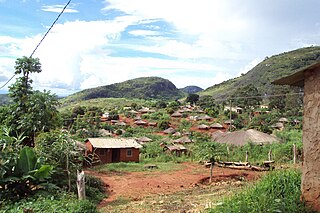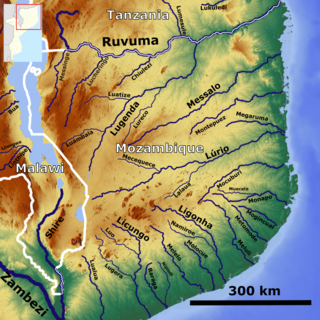
Modes of transport in Mozambique include rail, road, water, and air. There are rail links serving principal cities and connecting the country with Malawi, Zimbabwe and South Africa. There are over 30,000km of roads, but much of the network is unpaved.

Zambezia is the second most-populous province of Mozambique, located in the central coastal region south-west of Nampula Province and north-east of Sofala Province. It has a population of 5.11 million, according to the 2017 census. The provincial capital is Quelimane.

Beira is the capital and largest city of Sofala Province, where the Pungwe River meets the Indian Ocean, in the central region of Mozambique. It is the fourth-largest city by population in Mozambique, after Maputo, Matola and Nampula. Beira had a population of 397,368 in 1997, which grew to 530,604 in 2019. A coastal city, it holds the regionally significant Port of Beira, which acts as a gateway for both the central interior portion of the country as well as the land-locked nations of Zimbabwe, Zambia and Malawi.

Cuamba is a city and district of Niassa Province in Mozambique, lying north west of Mount Namuli. Before independence the town was known as Nova Freixo.

The Roman Catholic Diocese of Gurué is a diocese located in the city of Gurué in the Ecclesiastical province of Beira in Mozambique.

Gurué District is a district of Zambezia Province in Mozambique. The principal town is Gurué. Gurué is the country's largest tea-estate and has a population of around 116, 922.
Mocuba District is a district of Zambezia Province in Mozambique. The main town is Mocuba.
Morrumbala District is a district of Zambezia Province in Mozambique. The town of Morrumbala is the district headquarters.
Dois Lajeados is a municipality in the state of Rio Grande do Sul, Brazil. As of 2020, the estimated population was 3,405.
Ancuabe is a town in eastern Mozambique in Ancuabe District, Cabo Delgado Province. It is the seat of the district. According to the 1997 census it has a population of 12,561.

Silmo Mocuba, usually known simply as Silmo Mocuba, is a traditional football (soccer) club based in Mocuba, Mozambique.
Orbányosfa is a village in Zala County, Hungary.

The Licungo is a river of Mozambique in Zambezia Province. The river begins north of Gurúè and flows south to the Indian Ocean.

The history of rail transport in Mozambique began in the latter years of the nineteenth century.
Melbourne South Province was an electorate of the Victorian Legislative Council. It was created in June 1904 when Melbourne Province was reduced in size and North Yarra Province and South Yarra Province were abolished. The new Melbourne South, Melbourne North, Melbourne East and Melbourne West Provinces were then created.
Mocuba Solar Power Station, is an operational 40 megawatt solar power plant in Mozambique. The public–private partnership project, sells the energy produced to the national electric utility, Electricidade de Moçambique (EDM), under a 25-year power purchase agreement.
The 2020/21 Moçambola is the 43nd season of Moçambola, the top-tier football league in Mozambique. The 2020/21 season started on January 16, 2021 and is in progress.
Mozambique has abundant energy sources available for exploitation. As of 2021, the country was ranked first in energy potential of all the countries in the Southern African Power Pool (SAPP), with an estimated energy capacity of 187,000 MW. Available energy sources include coal, hydroelectricity, natural gas, solar energy and wind power. As of September 2021, the largest proportion of the power currently generated is from hydroelectric sources. However the energy mix in the country is changing. Natural gas powered energy stations are expected to provide 44 percent of total energy generation from 2020 to 2030.










